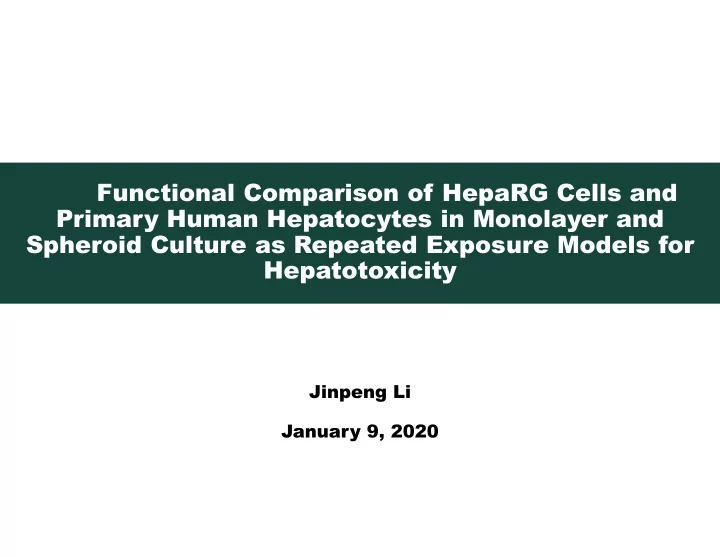

Functional Comparison of HepaRG Cells and Primary Human Hepatocytes in Monolayer and Spheroid Culture as Repeated Exposure Models for Hepatotoxicity Jinpeng Li January 9, 2020
Background • Predicting repeated exposure hepatotoxicity is of critical importance for the safety assessment of chemicals. • The advantage of human cell-based in vitro models: • 1) time- and resource-efficient • 2) genetically and physiologically relevant • The challenge of long-term in vitro culture of liver cells: • Rapid dedifferentiation in conventional monolayer culture. • Culture method 2D Sandwich culture 3D spheroid culture Extracellular Matrix Ultra low attachment Hepatocytes Collagen ~one week >3 weeks
Background • Primary human hepatocytes (PHH) Gold standard Limitations: availability, variability/reproducibility • HepaRG cell Derived from hepatocarcinoma 2D sandwich culture 3D spheroid culture Highly stable cell line Exhibit many characteristics similar to PHH: major xenobiotic sensors (PXR, CAR and AHR) • drug transporters • phase I and II drug metabolizing enzymes • hepatic transcription factors involved in stress response pathways • • Objective: Characterize and compare models for hepatotoxicity assessment after repeated exposure
Morphology • PHH • 2D: Day0 Day 1 Day 4 Day7 • 3D: Day 1 Day 4 Day7 Day 14 Day 21 Unpublished data
Morphology • HepaRG • 2D: Day0 Day 1 Day 4 Day7 • 3D: Day 1 Day 4 Day7 Day 14 Day 21 Unpublished data
Cellular ATP Viability (cellular ATP content) (RLU per 10 3 cells) 3 hr 4 day 7 day 4 day 7 day 14 day 21 day Cellular ATP (RLU per 10 3 cells) 3 hr 4 day Modified based on Li et al. (2019). Applied In Vitro Toxicology. 7 day 4 day 7 day 14 day 21 day
HepaRG PHH Metabolic activities Fold change relative to Fold change relative to freshly thawed cells freshly thawed cells 3 hr 3 hr 4 day 4 day 7 day 7 day 4 day 4 day 7 day 7 day 14 day 14 day 21 day 21 day Fold change relative to freshly thawed cells 0 2 4 6 8 3 hr 4 day Time after seeding 7 day CYP2B6 4 day 7 day 14 day 21 day Fold change relative to freshly thawed cells Modified based on Li et al. (2019). Applied In Vitro Toxicology. 3 hr 4 day 7 day 4 day 7 day 14 day 21 day
Urea production Spectrophotometry based measurement Amino acid Absorbance NH 3 (ammonia) Urea Liver Blood Equation Y = 0.01034*X - 0.0005075 Kidney R square 0.9987 Unpublished data
Urea production Urea (mg/L/10 6 cells) 3 hr 4 day 7 day 4 day 7 day 14 day 21 day Urea (mg/L/10 6 cells) 3 hr 4 day Modified based on Li et al. (2019). Applied In Vitro Toxicology. 7 day 4 day 7 day 14 day 21 day
Assessment of model sensitivity • Chemical treatment regimen Days 0 1 2 3 4 5 6 7 8 9 10 11 12 13 14 √ 2D_d7 (3) ↓ ↓ ↓ √ 3D_d7 (3) ↓ ↓ ↓ Acetaminophen √ 3D_d14 (6) ↓ ↓ ↓ ↓ ↓ ↓ ↓ : Chemical treatment √ : Viability assessment (ATP content) Aflatoxin B1
Assessment of model sensitivity Ibufenac PHH 6000 HepaRG Viability (% of vehicle) Viability (% of vehicle) EC50 ( M) 4000 10X Cmax 2000 Cmax 0 2D_7d 3D_7d 3D_14d 2D_7d 3D_7d 3D_14d 2D_7d 3D_7d 3D_14d EC50 2286 1613 1951 EC50 4793 3917 1979 Modified based on Li et al. (2019). Applied In Vitro Toxicology.
Assessment of model sensitivity PHH HepaRG Ibuprofen PHH 2D_7d 2D_7d 150 150 4000 HepaRG 3D_7d 3D_7d Viability (% of vehicle) 3D_14d 3D_14d 3000 100 100 EC50 ( M) 10X Cmax 2000 50 50 1000 Cmax 0 0 0 1 2 3 4 5 1 2 3 4 5 2D_7d 3D_7d 3D_14d Conc. (log[ M]) Conc. (log[ M]) 2D_7d 3D_7d 3D_14d 2D_7d 3D_7d 3D_14d EC50 2972 1664 1109 EC50 2958 1244 957.5 Modified based on Li et al. (2019). Applied In Vitro Toxicology.
Assessment of model sensitivity Acetaminophen PHH HepaRG Acetaminophen PHH 2D_7d 2D_7d 150 8000 150 HepaRG 3D_7d Viability (% of vehicle) 3D_7d Viability (% of vehicle) 3D_14d 3D_14d 6000 100 100 EC50 ( M) 4000 50 50 2000 Action level 0 0 0 1 2 3 4 5 2D_7d 3D_7d 3D_14d 1 2 3 4 5 Conc. (log[ M]) Conc. (log[ M]) 2D_7d 3D_7d 3D_14d 2D_7d 3D_7d 3D_14d EC50 3981 2516 1472 EC50 6038 1509 646.6 Modified based on Li et al. (2019). Applied In Vitro Toxicology.
Assessment of model sensitivity Aflatoxin B1 PHH HepaRG Aflatoxin B1 PHH 2D_7d 150 2D_7d 150 2.5 HepaRG Viability (% of vehicle) Viability (% of vehicle) 3D_7d 3D_7d 2.0 3D_14d 3D_14d 100 100 EC50 ( M) 1.5 1.0 50 50 0.5 Exposure level 0 0 0.0 -2 -1 0 1 2 -2 -1 0 1 2 2D_7d 3D_7d 3D_14d Conc. (log[ M]) Conc. (log[ M]) 2D_7d 3D_7d 3D_14d 2D_7d 3D_7d 3D_14d EC50 2.313 0.5606 0.1712 EC50 0.8975 0.1475 0.07675 Modified based on Li et al. (2019). Applied In Vitro Toxicology.
Summary PHH HepaRG 2D 3D 2D 3D Viability * ** * *** Hepatic phenotype * *** * *** Sensitivity * *** * *** Reproducibility * *** Availability * ***
Acknowledgement • Dr. Sue Marty • Dr. Matt LeBaron • Dr. Raja Settivari • CMT/TK Group
Thank you for your attention! ?
Recommend
More recommend